This form is for the everyday salaried individual. If your total income is up to Rs. 50 Lakh and mostly comes from your job or pension, ITR-1 is made for you.

ITR (Income Tax Return)
For those who want to file an ITR (Income Tax Return), let’s say you’ve already done the heavy lifting. You’ve figured out your taxable income, gone through your salary slips, maybe even tracked a few deductions along the way. But just when you think the finish line is near, you’re hit with a list of ITR forms—each with its own name, number and purpose.
At first glance, they might all look the same. But choosing the wrong one could mean delays, notices or even a rejected return. That’s why understanding the types of ITR forms—and more importantly, knowing which one applies to you—isn’t just a technicality. It’s a crucial step that ties everything together. In this blog, we decode the different ITR forms and help you find the one that matches your income profile.
ITR-1 (Sahaj)
This form is for the everyday salaried individual. If your total income is up to Rs. 50 Lakh and mostly comes from your job or pension, ITR-1 is made for you. It also fits if you earn a bit from interest or have a small amount (up to Rs. 5,000) from farming. You can even include rent from one house—but not if there are complicated tax claims or capital gains. If your income sources are basic and your taxes are straightforward, this is the most convenient form to file.
ITR-2
When your income crosses Rs. 50 Lakh or comes from multiple places—like foreign assets, more than one house or capital gains from selling shares or property—you’ll need ITR-2. This form works for individuals and HUFs (Hindu Undivided Families) who aren’t running a business but still have complex income details to report. If you’re investing globally or earning rent from multiple properties, this form covers that too.
ITR-3
If you’re a freelancer, consultant, shop owner or you run a business under your own name, ITR-3 is where your tax journey begins. It’s also the right form if you’re a partner in a firm or a director in a company. It handles professional income, business income and investment earnings—plus things like owning unlisted shares. In short, if you make your money by working for yourself or managing a firm, ITR-3 is built for that.
ITR-4 (Sugam)
This one’s made for small businesses, professionals and freelancers who use the presumptive taxation scheme—meaning, your income is calculated based on a fixed percentage, not detailed profit and loss. If your total income is within Rs. 50 Lakh and your business turnover is within the limit set by the presumptive scheme, ITR-4 makes tax filing quicker and simpler. It’s often used by shop owners, taxi drivers, independent consultants and others who want to avoid complex accounting.
ITR-5
ITR-5 is for groups and entities—not individuals. It covers partnerships (except LLPs), associations, co-operatives and other collective organisations like local authorities or estates. These are not personal returns—they represent businesses or trusts filing on behalf of a group of people or for a legal purpose.
ITR-6
This is the form that companies use—except those that are completely religious or charitable in purpose (they use ITR-7). ITR-6 must be filed online and it is required for all kinds of registered businesses like private limited companies and public companies that are not claiming exemption under Section 11.
ITR-7
This form is reserved for organisations and institutions that serve public good. Think temples, trusts, political parties, NGOs, medical institutions, colleges and think tanks. These are bodies that may not have regular income but still need to report how they’ve handled funds. They file under different sections of the Income Tax Act, based on their purpose—charity, education, research and more.
Final Thoughts
Other than the ITR forms themselves, there are a few supporting documents that make the filing process easier—like Form 16, which shows your salary and TDS details; Form 26AS, which tracks all the taxes paid on your behalf; and Form 15G or 15H, which help avoid TDS if you're within the exemption limit. These forms don’t replace your ITR, but they help you report your income accurately and match the numbers you've already worked out.
That’s all the forms you need to know. Once you've completed the step of how to calculate taxable income, choosing the right ITR form is the next key move. With the right form in hand, you're all set to file your return correctly—whether you do it on your own or with the help of a tax filing platform.
 Subscribe today by clicking the link and stay updated with the latest news!" Click here!
Subscribe today by clicking the link and stay updated with the latest news!" Click here!








